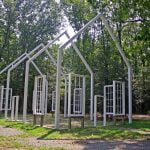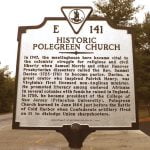It is Simply Known as Old Tennent
by Rev. David T. Myers
Would you join a church congregation if the original members of the church were branded on their faces with a “T” for traitor? Or had their ears “cropped” and disfigured as a permanent sign of their rebellion? I dare say most modern Christians might hesitate for a moment, wondering about the background of these members. But what if you discovered through investigation that these members had resisted the government’s attempting to overturn their Presbyterian convictions with those of the official state church? I dare say that we who are true and faithful to the Word of God—the Bible—would quickly stand by their side and declare ourselves to be faithful adherents in such a church.
Such were the original members of what is simply known as Old Tennent Church, a hardy group of Covenanters who came to these American shores in the late seventeenth century. More specifically, they came to Monmouth County, New Jersey, in 1685, where they had been sent by the Crown as indentured servants. As they worked off their “punishment,” they established in 1692 on a small acre of ground, a tiny log church, about the size of a cabin, as their worship center. They called it “Free Hill.”
Fast forward to when the small group of believers, under the spiritual oversight of Ruling Elder Walter Ker, aligned themselves with the newly begun Philadelphia Presbytery, of which we have written before in these posts. In fact, there is some discussion as to whether that Presbytery actually met at Old Tennent rather than in the Philadelphia area. Elder Walter Ker, who was known as “the Father of Old Tennent”, believes it did meet at Old Tennent.
It was on this day, June 3, that the steadily growing church was organized as a particular church in the Philadelphia Presbytery. Its first pastor was the first Presbyterian pastor ordained in the colonies, namely, John Boyd. Later, two of the Tennent brothers, John and William Tennant filled the pulpit, with the latter occupying that pulpit for several decades. Under the leadership of William Tennent the church was a central part of the Great Awakening, that wide-spread revival then filling the land. As a result, men like George Whitefield, Gilbert Tennent, and Jonathan Edwards were also there on occasion to fill the pulpit at Old Tennent. In one instance, the Presbyterian missionary David Brainerd administered the Sacrament to a number of Indian converts in its sanctuary.
The original structure has been restored at various times, but its sanctuary continues to be active with members, friends, and visitors, being a member congregation of the Presbyterian Church, USA.
Words to Live By:
Whether Old Tennent Church was the location where the Presbytery of Philadelphia began or not, we still can rejoice in this church’s founding and subsequent early history for the faith once delivered unto the saints. This author wishes he could state that this church is now part of the Presbyterian Church in America, but that is not the case. Let us however not simply rejoice in the early history of Presbyterian churches, but every day and with all our heart and mind, continue the Reformed faith—the clear proclamation of the Gospel of salvation in Jesus Christ our Lord—in our families, to our fellow members in evangelical and Reformed churches with which we are affiliated, and in the communities in which we live. Point them to Christ as our only Hope and our sure Salvation.


